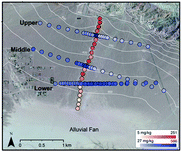 A quantitative model to predict arsenic concentration patterns in the area surrounding abandoned mining sites has been developed in this recently published HOT paper.
A quantitative model to predict arsenic concentration patterns in the area surrounding abandoned mining sites has been developed in this recently published HOT paper.
The model looks at the fluvial transport of arsenic from mine waste in semi-arid areas, which has a significant contribution in the distribution of contaminants from the original source – particularly after heavy rain. Despite the important role of fluvial transport, it has been somewhat overlooked to date – perhaps because of the intermittent and unpredictable nature of our weather systems.
James Rytuba from the U.S. Geological Survey, and colleagues from Chapman University hope that their model will help inform environmental remediation strategies for arsenic and other related contaminants in similar environments.
Read the details of the model here – the paper is free to access for 4 weeks:
Fluvial transport and surface enrichment of arsenic in semi-arid mining regions: examples from the Mojave Desert, California
Christopher S. Kim, David H. Stack and James J. Rytuba
DOI: 10.1039/C2EM30135K










